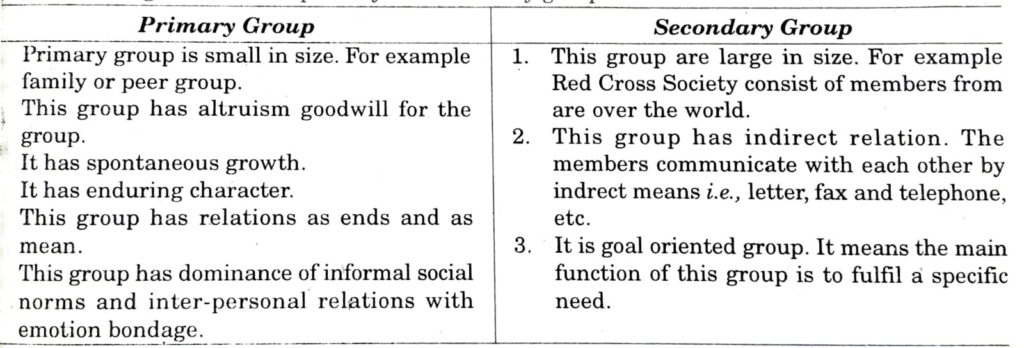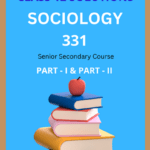NIOS Class 12 Sociology Chapter 6 Social Group, Solutions to each chapter is provided in the list so that you can easily browse through different chapters NIOS Class 12 Sociology Chapter 6 Social Group and select need one. NIOS Class 12 Sociology Chapter 6 Social Group Question Answers Download PDF. NIOS Study Material of Class 12 Sociology Notes Paper 331.
NIOS Class 12 Sociology Chapter 6 Social Group
Also, you can read the NIOS book online in these sections Solutions by Expert Teachers as per National Institute of Open Schooling (NIOS) Book guidelines. These solutions are part of NIOS All Subject Solutions. Here we have given NIOS Class 12 Sociology Chapter 6 Social Group, NIOS Senior Secondary Course Political Science Solutions for All Chapters, You can practice these here.
Social Group
Chapter: 6
MODULE 1: SOCIOLOGY – BASIC CONCEPTS
INTEXT QUESTIONS 6.1
Write answer in one sentence:
(a) What do you understand by a social group?
Ans. Social groups refers about basic units where human beings live.
(b) Can groups be called ‘Social bricks’ if so, why?
Ans. Yes, groups can be called ‘social bricks’ because as bricks make build of similarly groups make society.
(c) Do you agree with the statement that society is made up of groups?
Ans. Yes, I agree with the statement that society is made up of groups.
(d) Give an example of group.
Ans. Family or Political party is an example of group.
INTEXT QUESTIONS 6.2
Write answer in one sentence:
Q.1. Write the three classifications of roups based on nature of contacts.
Ans. (a) Primary groups.
(b) Secondary groups.and
(c) Tertiary groups.
Q.2. In which type of group do you find face to face relations?
Ans. In primary group, find face-to-face relation.
Q.3. In what type of political party covers?
Ans. Secondary.
INTEXT QUESTIONS 6.3
Fill in the blanks with appropriate words from this section:
1. An examples of Horizontal groups is ……………… group.
Ans. peer.
2. Case, class and bureaucracy are examples of …………….. groups.
Ans. vertical.
3. For uneducated unemployed, salaried class constitute a ………………. group.
Ans. reference.
4. In open groups mobility of members is …………….. .
Ans. possible.
INTEXT QUESTIONS 6.4
Tick mark (✓) the correct answer and put (x) against wrong answer:
1. We feeling marks primary group.
Ans. (✓).
2. Group is marked by a standard rules and norms.
Ans. (×).
3. Group consists of many communities.
Ans. (×).
TERMINAL EXERCISES
Q.1. Distinguish between primary and secondary groups. (V.Imp.)
Ans. Distinguish between primary and secondary groups:


Q.2. Describe the characteristics of a social group.
Ans. A social group has the following characteristics:
1. Number of person: At least two persons have to be there in a group.
2. Membership consciousness: Each member is conscious of his or her membership in his or her group.
3. Organised structure: Every group structurally organised.
4. Interaction with a meaning and purpose: Interaction takes place between members with definite meaning and purpose.
5. Sense of belongingness: There is a ‘We’ feeling in a group.
6. Common goals and interests: Members of a group often share common goals and work together for their realisation, e.g. members of a cricket club are bound with each other to play the game of cricket to win a match.
7. Group norms: Each group has its own rules or norms, which the members are expected to follow.
8. Comparative enduring character: Each group possesses relative permanency.
9. Nomenclature: Largely each group is known by a name.
10. Specific culture likes language and symbols: Each group possesses specific rules of behaviour, specific styles of interaction and language and symbols to communicate.
11. Reciprocal relations: The members of a group are reciprocally related to each other. For instance in a family, all the members are bound with each other through bonds of kinship.
Q.3. What is difference between group and community? (M.lmp)
Ans.
| Group | Community |
| 1. Group is created. | 1. It grows naturally and is also Created. |
| 2. Group may be formed for certain purposes. | 2. Community involves the Whole life of its members. |
| 3. Comparatively temporary. | 3. Comparatively permanent. |
| 4. Group is a part of community. | 4. Community consists of many groups. |
Q.4. Describe in-group and out-group in your own words.
Ans. In-group and out-groups: On the basis of feeling we can make distinction between in-group and out-group.
1. In-group refers to that aggregate members who interact with a sense of intra-group solidarity (solidarity with group). Thes members possess prejudices (biases) are superiority-inferiority complex, toward several other groups, which are called ‘outgroups’.
2. In-group always evaluate out-group based on own cultures. So, superiority and inferiority dimensions take place. The consciousness is identified as ‘ethno-centrism.
Example: For instance, in a village upper castes and lower castes are ‘in-group’ themselves but for one another each become an ‘out-group’.
3. In common sense in-groups are called ‘we-groups’ and out-group are known as the groups’.
SOME OTHER IMPORTANT QUESTIONS FOR EXAMINATION
VERY SHORT ANSWER TYPE QUESTIONS
Q.1. Fill in the blanks with suitable word or words:
(a) Concepts like society, community, association and institutions refer to …………….. that help us to make sense of how human beings live.
Ans. groups.
(b) Social groups are the basic units where human beings live, lead their life and enter into meaningful …………….. .
Ans. inter-actions.
(c) Human beings living in society do not lead an …………….. life.
Ans. isolated.
(d) Human beings are social …………….. .
Ans. animals.
(e) A …………….. group is simply a number of people who interact with each other on a regular basis.
Ans. social.
(f) In a family, all the members are bound with each other through ……………… .
Ans. bonds of kinship.
LONG ANSWER TYPE QUESTIONS
Q.1. Explain the major criteria used for classifying groups.
Ans. Major criteria used for classification of Groups: Generally criteria like size, proximity, complexity membership, goal and means are used to classify groups.
We know very well that all groups are not alike. Everyone of us can see differences among various groups based on size, proximity, complexity, membership, goal and means.
1. Size: Some groups are small while others are large. For example, a family is generally a small group in size, while political party may be very big i.e. membership.
2. Other Major Criteria: Groups may be divided into primary, secondary, in-groups, out-groups, membership, non-membership, formal informal, etc.
3. Relationship: On the basis of individual’s orientation in relation to a group, the concept of – group has also taken shape in sociology.
4. Intimate Groups: These groups are always large in size.
5. Impersonal Groups: These groups are always large in size.
6. Primary Group: These are always small in size. It refers to small associations of people connected by ties of emotional feelings.
7. Secondary Group: Impersonal, formal and indirect relations prevail among the members of this type of group.
8. In Group: These groups are ‘we groups: any individual ‘Ingroup’ is the group to which he belongs. The groups with which the individual identifies himself are his ingroups: family, tribe, sex, college, or occupation by virtue of one’s awareness of likeness or consciousness of kind.
9. Out Group: These groups are ‘They group’ or ‘Others group’. An outgroup is a circle of people to which an individual feels no sense of belongingness. For examples, a tiller of the soil in our country views his landlord as outgroup. It follows that outgroup is defined by the individual with relation to the ingroup, generally expressed in the contrast between ‘we’ ‘they’ or ‘other’.
10. Formal Groups: These groups tend to be either large or a part of a large organisation. An army and a labour union is the example of formal group.
11. Informal Groups: These are social units which have all group characteristics. They have established system of interpersonal relations, joint activities, the feeling of belongingness to a group but they lack any legal staus. For example clubs or sports sections, societies etc.

Hi! my Name is Parimal Roy. I have completed my Bachelor’s degree in Philosophy (B.A.) from Silapathar General College. Currently, I am working as an HR Manager at Dev Library. It is a website that provides study materials for students from Class 3 to 12, including SCERT and NCERT notes. It also offers resources for BA, B.Com, B.Sc, and Computer Science, along with postgraduate notes. Besides study materials, the website has novels, eBooks, health and finance articles, biographies, quotes, and more.




